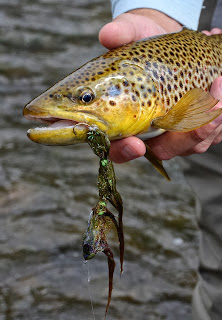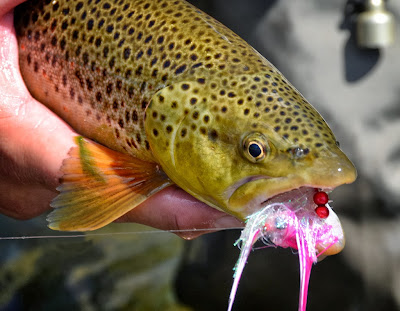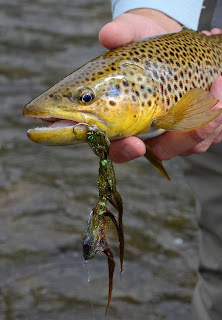Durable workhorses of the bench
![]() |
| Apex vise and Versa-Clamp |
I love gear. There, I said it... I love trying out new or existing stuff, and I'm usually pretty adaptable when it comes to rods reels, etc. I'm a bit more particular when it comes to vises, so I was really excited to get the opportunity to tie for the last several weeks on Wolff Indiana's Atlas and Apex vises. I was also able to review one of the best c-clamps (the Versa Clamp) that I have used (I'll go into detail later in this post). These vises are the same vises that were made famous under the Anvil name, the only difference is that they now bear the Wolff name.
What really interested me in these vises, is that they are made in the USA, they looked to be very well made, and they had an
excellent price point. The Apex vise retails for about $99, and the Atlas vise retails for about $149, so they fall right into the same price range as some of the other popular vises in the market.
Both vises are designed around essentially the same jaw. It is a smaller profile jaw that I immediately knew I would like for tying the small stuff, but how would it handle the bigger stuff? Remember, in my opinion, a good vise should be able to hold
any hook without having to switch jaws, or adjust too much. What I found in the jaw were two strategically placed notches that allow you to seat the larger stuff. 100% lockout on big hooks - check. I did find that I had to find a happy medium with notches the Atlas, but the Apex was a bit easier to manipulate. I'll explain later.
Apex Vise (Traditional style vise)![]() |
| Wolff Apex Vise |
Most of you know by know that I'm a die hard rotary guy. I don't really go out of my way to tie on non-rotary stuff, but this little vise kept finding it's way into my starting lineup, in fact, on a recent trip to Michigan for work, it is the vise that I took with me due to it's small size and simple design. If it can make it through the TSA and the brutal baggage carriers from Delta Airlines (my box of tungsten beads wasn't so lucky), you know that it's well made.
Pros:
- Very well made. Clean design with mostly machined metal parts.
- The jaw plain holds hooks. In fact, I think this will be my new go-to vise when I'm wrapping up anything under a #20. The fine points on this jaw give you maximum room to work with even #32 hooks (yes... I tied several 32's on it).
- The notches really line up well with larger hooks, and I was able to achieve positive lockout on hooks as big as 4/0.
- The clamping mechanism has a long lever making it very easy to clamp hooks in with an easy squeeze of your fist. (Much easier than on the Atlas). I really liked this function because it helps with hand fatigue.
- It comes with both a pedestal base and a c-clamp (not the versa clamp pictured, but still a good clamp).
- This is one of the BEST options for a new tyer that is trying to stay under $100 on a vise.
Cons:
- When tying on this vise, there is a very slight amount of play in the connection where the jaw meets the stem. It didn't bother me at all when I tied on it, but it might bother you if you are a wierdo with OCD like cough... cough... cou-Curtis...
- I had to do a very slight amount of tuning to the vise, and it got more smooth as I tyed on it more. I added reel oil to the threaded adjustment on the back of the jaw. It also seemed like the clamping motion got more smooth the more that I clamped it. It was kind of rough at the beginning.
- The pedestal base on this one is too small for tying bigger flies. If I were going to be doing deer hair, or bigger bugs, I'd get a larger base, or put it in the c-clamp
- The stem is a bit short for the c-clamp. It still works, and I tie with the vise fairly low so it worked great for me, but if you like your vise at head height while tying, this stem is too short for that.
- The material clip kept moving around on me. If I were going to tie on this vise long term, I'd find a way to stick the clip in one place without having to worry about it slipping off the front of the vise.
In all, I think this vise is one of the best sub $100 vises on the market. It's made in the USA, and as I said, I think I might just adopt this one for the fine and micro stuff. This is a very solid vise.
![]() |
| Wolff Atlas Vise |
I was most excited to get this vise because I really prefer to tie on a true rotary vise. I did my best to put this thing through it's paces and tied every type and size of fly imaginable, and the verdict is that it basically holds any hook you throw at it... almost. I'll talk about the notches and the angle of the jaw in a bit. Again, USA made, 99% machined metal parts - this one is built to last a lifetime as well.
Pros:
- This thing is bulletproof. It is designed to last the test of time as I mentioned with the Apex.
- Holds a wide range of hooks, especially the small ones.
- For $150 you can get a fully functional true rotary vise. This one definitely hangs side by side with the Peak vise.
- The jaw adjusts up and down, allowing you to achieve true rotary with any size of hook.
- The pedestal base is very wide and heavy. This thing won't tip when you are cranking on that buck tail musky bug with GSP thread.
- It also comes with a c-clamp
- I like the longer rotary stem that comes off the back of the vise. This makes it easier to get a hold of and control even when you are just positioning the vise at an angle and not "tying" rotary style
Cons:
- The angle of the jaw, and the notches in the jaw, don't lend themselves to easily place large hooks in it. The Apex was much easier, because the jaw can be adjusted to a less extreme angle, but because of this angle on the Atlas, the notches try to grab the hook where there it typically a pretty extreme bend of the hook. The notches are straight, not curved. This being said, I could get a hook to sit in the notch, it just took some practice to get used to it. Not a deal breaker at all.
- The tensioning device on the back of the vise would loosen every so often. I know that I could have fixed it if it were the vise that I was going to be tying on all the time, but I chose not to. No big deal because most vises require a bit of tuning at first.
- It was a bit rigid at first with the clamping mechanism on the jaw, but like the Apex, it broke in very shortly with use and a bit o' lube.
- The material clip is lacking on this vise. It's too small, and the gaps in the spring are a bit too wide. There are many after-market clips available, but I found that I had to craft my own (as I have done with several other vises). This really isn't a big deal to me because many vises are sold without material clips at all.
All this being said, If I had to chose a vise between this one and the Peak (same price category), I'd blindfold myself and throw a dart at their pictures on the wall. Whichever picture I hit would be the winner. These vises are about the same when it comes to functionality. Yes, that means that this is a really, really good vise for a bill and a half.
Versa Clamp (See top picture)
Oh how I wish I would have had this back in my days of tying with my c-clamp Renzetti Traveler. If I would have had this bad boy, I would very likely still be tying on a c-clamp vise. This is hands down the best clamp that I have used. As you will see on the top picture, this clamp is designed to be used a variable widths that can be adjusted easily. The main reason I changed to a pedestal base is that my c-clamp wouldn't fit on some surfaces. This clamp would have taken care of that issue for me - no problem. It also has two bolts that lock down the shaft of the vise.
Pros:
- This is the best c-clamp in the world
Cons:
- See above. There are no cons
All things being said, Wolff makes high quality products that are made to last a lifetime. If I were deserted on an island with only a Wolff vise... I'd be a happy man.
~ Cheech



.jpg)







































